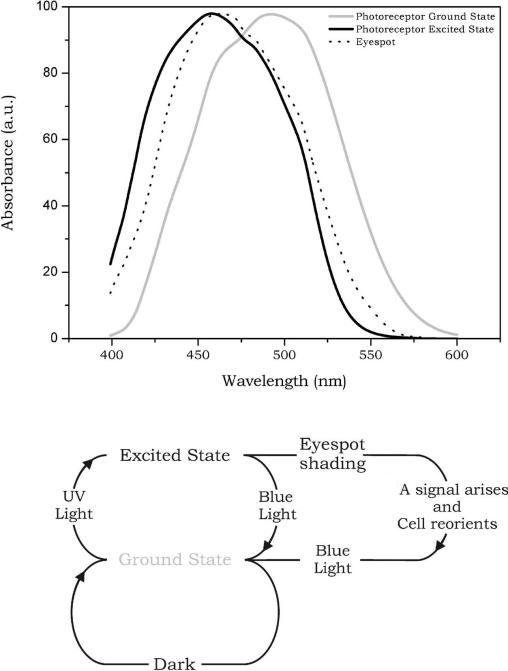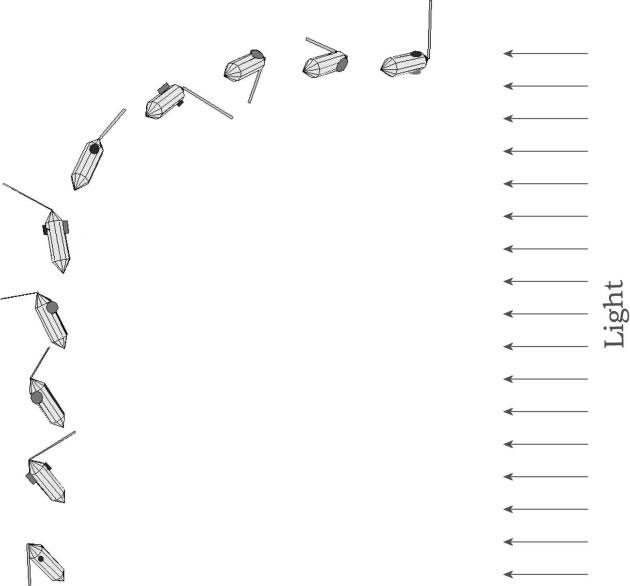An Example: Photoreceptor and Photoreception in Euglena
We can utilize all the earlier mentioned theoretical information as a frame and put in this frame the particular experimental knowledge that we possess on a typical algae photoreceptor system. Let us
examine in detail the case of Euglena that possesses a Type II photoreceptor system. This system
consists of the eyespot and the photoreceptor located inside the locomotory flagellum. As the cell rotates while swimming, the eyespot comes between the light source and the photoreceptor, thus
modulating the light that reaches it, and regulating the steering of the locomotory flagellum. Different experimental data exist providing evidence that the photoreceptor of Euglena could use either
rhodopsin-like proteins or flavoproteins. In 2000 Barsanti et al. isolated the photoreceptors of
Euglena in very high yield and performed the purification of a rhodopsin-like protein from this
sample. Just recently Iseki et al. (2002) biochemically characterized a new type of blue-light receptor
flavoprotein, a photoactivated adenyl cyclase, in the photoreceptor organelle of Euglena. Though is not yet certain which is the primary light detecting protein in the photoreceptor, still a model of how Euglena orients itself in a luminous field can be provided.

FIGURE 2.73 Absorption spectra of the photoreceptor ground state (continuous gray line) and excited state (continuous black line) and absorption spectrum of eyespot (dotted line) of Euglena gracilis. The photocycle of the photoreceptor and shading effect of the eyespot are shown in the bottom part of the figure.
The photoreceptor possesses optical bistability, that is, upon photoexcitation the ground state
generates a stable excited state, which can be photochemically driven back to the ground state.
Euglena photoreceptor undergoes a very simple photocycle: UV light (365 nm) of the non-fluorescent
ground state leads to the photogeneration of the fluorescent excited state, which in turn is
driven back to the ground state by blue light (436 nm). Figure 2.73 shows the absorption spectrum
of the ground and excited states of the photoreceptor, together with the absorption spectrum of the
eyespot. The latter spectrum clearly overlaps the excited state spectrum of the photoreceptor. The
photocycle of the photoreceptor and shading effect of the eyespot are shown in the bottom part of
the figure.

FIGURE 2.73 Absorption spectra of the photoreceptor ground state (continuous gray line) and excited state (continuous black line) and absorption spectrum of eyespot (dotted line) of Euglena gracilis. The photocycle of the photoreceptor and shading effect of the eyespot are shown in the bottom part of the figure.
As the cell rotates while swimming (rotation frequency: 2 Hz, that is, two complete revolutions
per second), the photoreceptor experiences periodic shading by the eyespot, which comes between
the light source and the organelle. As the absorption spectra of the eyespot and that of the excited
state of the photoreceptor are superimposable, the screening effect of the eyespot leads to the interruption of the photocycle, preventing the transition of the excited state of the photoreceptor to its ground state, hence a signal can arise. Cell reorientation is brought about by a selective screening of the absorption window of the excited state of the photoreceptor by the eyespot.

FIGURE 2.74 Dynamics of the light alignment of a model Euglena gracilis. The cell is represented by an ellipsoid, the eyespot by a big spot, the photoreceptor by a small spot. The asterisk indicates the extension of the flagellum and the tumbling of the cell.
During the entire shading period, the photoreceptor is in the excited state, which could generate
a photoelectric signal due to the change in dipole orientations between the excited and parent conformers of the photoreceptive protein. Under the influence of this electric field, a displacement photocurrent could be propagated through paraxial rod filaments via charge transfer between rod
proteins, which in turn generates longitudinal waves of contraction along the paraxial rod. The contractility of the rod should regulate the flagellum movement, turning the cell body towards the light source. The ground state of the photoreceptor is restored when the photoreceptor again achieves the alignment with the light.
The dynamics of the light alignment of a model
Euglena gracilis that obeys the earlier mentioned constraints is shown in Figure 2.74. The initial orientation of the cell is perpendicular to
the light direction, but in few seconds,
E. gracilis is completely aligned with the light.
The CRC Handbook on Organic Photochemistry and Photobiology (2004) is an excellent text that covers all the aspects of algae photobiology.

FIGURE 2.74 Dynamics of the light alignment of a model Euglena gracilis. The cell is represented by an ellipsoid, the eyespot by a big spot, the photoreceptor by a small spot. The asterisk indicates the extension of the flagellum and the tumbling of the cell.







